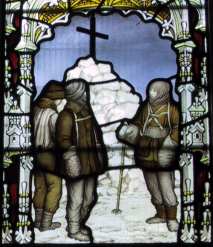Binton
| Binton | |
 Binton |
|
| Population | 311 (2011 census) |
|---|---|
| OS grid reference | SP145545 |
| District | Stratford-on-Avon |
| Shire county | Warwickshire |
| Region | West Midlands |
| Country | England |
| Sovereign state | United Kingdom |
| Post town | Stratford-upon-Avon |
| Postcode district | CV37 |
| Dialling code | 01789 |
| Police | Warwickshire |
| Fire | Warwickshire |
| Ambulance | West Midlands |
| EU Parliament | West Midlands |
| UK Parliament | Stratford-on-Avon |
|
|
Coordinates: 52°11′11″N 1°47′43″W / 52.186322°N 1.795231°W
Binton is a village and civil parish in the Stratford district of Warwickshire, England. It is about five miles (8 km) west of Stratford-upon-Avon. According to the 2001 census it had a population of 272.[1] increasing to 311 at the 2011 census.[2]
History
Binton Manor was bought by Edward Viscount Conway of Ragley Hall in 1670 and the title remains in his family. In the 19th century, the Conways possessed most of the village and proceeded to build the present church in 1875, on the site of a much older one. A picture of the original church can be seen at the back of the current church. Between the Norman Conquest and the Conways' buying of the Manor, it had belonged to many different families. The Wyncote family held it for the longest period: from 1325 until 1531.
The name Binton probably derives from Bina’s Ton (or town), Bina being a former Anglo-Saxon owner of the village.
Binton is unusual in that it has four entries in the Domesday Book of 1086. There were four major landholders named William, Gerin, Urso and Hugh. The total value of all their property was £8 and 10s, a lot of money at the time. Adding together the figures given gives an area of 1,538 acres (6 km2), whilst the modern parish is only 1,300 acres (5 km2). This is because some of the original manor is now in Temple Grafton parish. Therefore, according to the Domesday Book, in 1086, Binton had a population of 29 families with 150 people working seven ploughs and three mills. Altogether, this is very impressive for an eleventh-century manor.
This agricultural activity appears to have continued down the centuries. In the 19th century, a rector of Binton, trying to raise money for the church, said that most of the inhabitants were agricultural workers and were therefore unable to contribute. He was therefore required to ask the local gentry instead.
In the 19th century Binton gained many new facilities. In addition to the church and rectory, there was the village spring across the road from the church, and, in the main street, a school, a village shop, a post office, and a pub (The White Horse). There was a forge and, on the main Evesham Road, there was the railway station. The school, shop, post office, pub, forge and railway station no longer exist, due to the process of gentrification, where agricultural workers have been replaced by retired people and commuters who work in the surrounding area.
There is a parish council. In local government, the village was put in Stratford Rural District Council at its inception in 1894, and then, 80 years later, was absorbed into the larger Stratford District, which is where it is today.[3]
St Peter's Church
St Peter's Church is the Anglican church in the village and there has been a church on the site since at least 1286. The current church was built in 1875 and has views south over the river Avon, Warwickshire and the Cotswolds. It was mainly paid for by the Marchioness of Hertford.
Signs of the original church remain, however. There is a fifteenth-century font and cover and a mediaeval parish chest with three locks and bound with iron bands. Furthermore, there is a stained-glass window in memory of Sir John Greville, who died in 1480 and was an MP in five Parliaments. He is buried in Weston-on-Avon. The window depicts the arms of the Greville family of Milcote. There is also a piece of wood depicting the royal coat of arms. It must date from 1714-1801 as it includes the white horse of Hanover. Finally, by the gate to enter the churchyard, there are steps built into the wall, so as to avoid using the gate. The purpose of these was for people arriving to church by horseback could easily dismount,there is still a ring by these steps where the horses would be tied.[4]

The main feature of the church of St Peter is a memorial window by Kempe (1915), dedicated to Robert Falcon Scott and his co-explorers who died in their failed attempt to return from the South Pole. The window shows four scenes of the 1912 expedition. Scott had married Kathleen Bruce, sister of the Reverend Lloyd Harvey Bruce, Binton's rector 1906-24. Scott frequently visited the Rectory (now The Grange). Alongside the window is a memorial cross for the Revd Bruce, with a bronze sculpture of Christ designed by Kathleen.
The church has one bell, cast by Henry Bagley of Chacombe in 1669.
Just to the right of the church porch is the tomb of William Jackson and his wife, who lived in "Springback", now The Old Wellhouse. Jackson provided the stone wellhead known as “Buckwell” or “Lion’s Mouth" by piping water from a well in his own garden.[4]
The church supports a colony of nesting swifts.
Education
The nearest primary school is in Temple Grafton. The nearest secondary schools are in Stratford-upon-Avon and Alcester.
References
- ↑ "Civil Parish population 2001".
- ↑ "Civil Parish population 2011". Retrieved 24 December 2015.
- ↑ Binton village history by John Winterburn Archived 25 June 2007 at the Wayback Machine.
- 1 2 Binton Parish Council
External links
| Wikimedia Commons has media related to Binton. |
